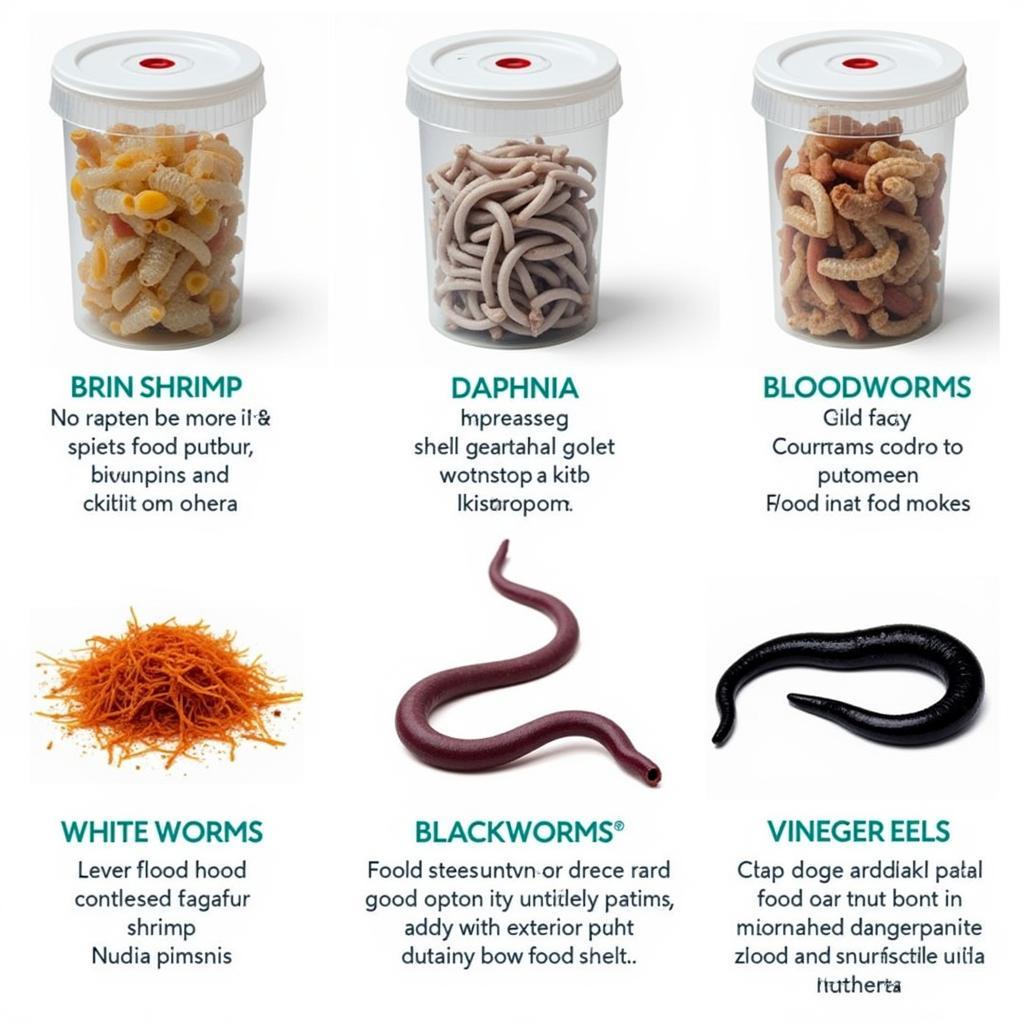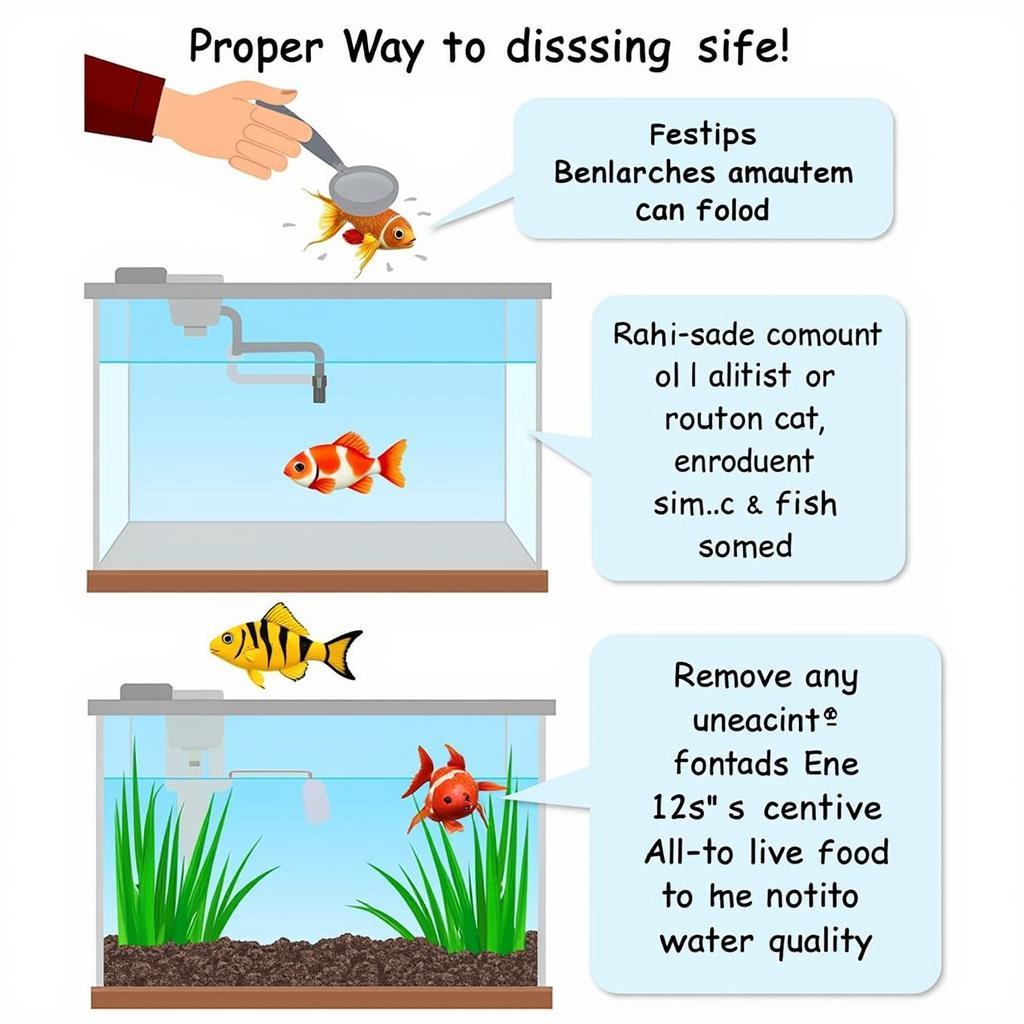Live Food For Fish offers a nutritional powerhouse, mimicking their natural diet. From boosting their immune system to enhancing their vibrant colors, live food provides numerous benefits that processed foods often lack. This guide explores the world of live food, covering everything from the nutritional advantages to practical tips on culturing and feeding. We’ll dive deep into the various types of live food available and help you choose the best options for your aquatic companions. You can learn more about specific fish diets, such as the best food for angelfish.
Why Choose Live Food for Fish?
Live food provides essential nutrients in their most bioavailable form, making it easier for fish to digest and absorb. This leads to faster growth, increased energy levels, and improved overall health. For breeding fish, live food is crucial for stimulating spawning behavior and ensuring healthy fry development. Furthermore, the natural hunting behavior elicited by live food provides mental stimulation and enrichment, reducing stress and boredom in your fish.
Types of Live Food for Fish
The world of live food for fish is diverse, offering a range of options to suit different species and aquarium setups. Some of the most popular choices include:
- Brine Shrimp: Easy to culture and readily available, brine shrimp are an excellent starter live food, especially for smaller fish and fry.
- Daphnia: Known as water fleas, daphnia are another readily available and nutritious option, rich in protein and essential fatty acids.
- Bloodworms: Packed with protein and iron, bloodworms are a highly nutritious treat for most fish species, contributing to vibrant coloration.
- White Worms: A good source of protein and fat, white worms are particularly suitable for bottom-dwelling fish.
- Blackworms: Similar to white worms but slightly larger, blackworms are also a nutritious option for bottom feeders.
- Vinegar Eels: Easy to culture and ideal for fry and smaller fish, vinegar eels offer a convenient and readily available live food source.
 Variety of Live Food Options for Aquarium Fish
Variety of Live Food Options for Aquarium Fish
Culturing Live Food at Home
Culturing your own live food can be a cost-effective and rewarding experience. It ensures a constant supply of fresh, nutritious food for your fish, free from harmful preservatives or contaminants. Many types of live food, such as brine shrimp and vinegar eels, are relatively easy to culture at home using simple setups.
What is the Best Live Food for My Fish?
The best live food for your fish will depend on their species, size, and dietary requirements. For example, smaller fish and fry thrive on brine shrimp and daphnia, while larger, carnivorous species benefit from meatier options like bloodworms. Consider your fish’s natural diet and choose live food that closely resembles it. For more on the food chain in aquatic environments, you can explore resources like the food chain of a sea turtle.
How to Feed Live Food to Your Fish
Introduce live food gradually to avoid overfeeding and maintain water quality. Observe your fish during feeding to ensure they consume the live food offered. Remove any uneaten live food after a few hours to prevent it from decaying and impacting water quality.
 Feeding Live Food to Aquarium Fish
Feeding Live Food to Aquarium Fish
Benefits of a Varied Diet with Live Food for Fish
A varied diet, including live food, is essential for the optimal health and well-being of your fish. Live food provides crucial nutrients, enhances their natural coloration, and stimulates their natural hunting instincts. The mental enrichment provided by chasing live food reduces stress and boredom, contributing to a happier, healthier aquarium environment. If you’re looking for balanced nutritional options for other pets, you might find resources on fit and healthy cat food helpful.
Conclusion
Live food for fish is a valuable addition to any aquarium, offering a wealth of nutritional and enrichment benefits. By incorporating live food into your fish’s diet, you’re providing them with the essential nutrients they need to thrive. From boosting their immune system to enhancing their vibrant colors and stimulating their natural behaviors, live food contributes to a healthier, more vibrant aquarium environment. So, explore the world of live food for fish and discover the difference it can make in the lives of your aquatic companions. For further insights on various dietary needs within the aquatic world, you can refer to the article on live food for freshwater fish.
FAQs
- How often should I feed live food to my fish? Live food can be offered as a treat a few times a week or as a staple part of their daily diet, depending on your fish’s needs.
- Where can I purchase live food? Live food is available at most aquarium stores and online retailers.
- Is it safe to culture live food at home? Yes, culturing live food at home is safe and relatively easy, as long as you follow proper hygiene procedures.
- Can live food carry diseases? While it’s possible for live food to carry diseases, sourcing from reputable suppliers and culturing your own live food minimizes this risk.
- What if my fish don’t eat live food? Some fish may be hesitant to try live food initially. Try introducing it gradually or offering different types of live food.
 Culturing Live Food at Home
Culturing Live Food at Home
For any assistance, please contact us at Phone: 02437655121, Email: minacones@gmail.com, or visit us at 3PGH+8R9, ĐT70A, thôn Trung, Bắc Từ Liêm, Hà Nội, Việt Nam. We have a 24/7 customer service team.